India Catalina
 From Wikipedia the free encyclopedia
From Wikipedia the free encyclopedia
Catalina | |
|---|---|
 Statue of India Catalina in Cartagena de Indias. | |
| Born | c. 1495 |
| Died | May 11 1538, Cartagena de Indias. |
| Occupation(s) | Translator, interpreter |
| Known for | Translator for Pedro de Heredia during the Spanish conquest of the Chibchan Nations. |
| Spouse | Alonso Montañez |
India Catalina (1495- May 11, 1538) was an indigenous child of Mokaná ethnicity from the Colombian Atlantic coast, who was kidnapped by Pedro de Heredia to be an interpreter and intermediary, playing a role in the Spanish conquest of Colombia.
History[edit]
Catalina, the daughter of a local chief, was abducted in 1509 by Spanish conquistador Diego de Nicuesa from an indigenous settlement known as Zamba o Galerazamba in the department of Bolívar.[1][2][3] She was sent to Santo Domingo, where she learned the Spanish language and adopted the Catholic Christian faith, although she was still considered a slave.[4] She served as an interpreter to the Native Americans under Pedro de Heredia during his conquest of Colombia.[5] She was also his concubine for many years,[6][7] but after she took him to court for stealing gold,[8][9] it is possible that Pedro had her married to his nephew Alonso Montañez.[10] She died in Cartagena de Indias on May 11, 1538.
The name "india (the indian) Catalina" appeared in a letter sent for Pedro de Heredia to King Carlos V in 1533. Her indigenous name was never mentioned in the documents.
According to the Colombian drama series "La reina de Indias y el conquistador" (The Queen and the Conqueror), her indigenous names are Katalydeyewua and Kaitegua.
Monument[edit]

The monument to India Catalina was sculpted by Eladio Gil Zambrana and presented to the public in 1974. Small scale replicas are used in the Cartagena Film Festival awards.[11]
See also[edit]
References[edit]
- ^ Archivo General de Indias. Probanza de Álvaro de Torres, Alguacil del Cartagena. Santa Fe, 80, N. 10 A, fol. (41 r) 2.
- ^ De Castellanos, Juan. Historia de Cartagena, op. cit., p. 22.
- ^ Simón, Pedro, Fray, op. cit., Tomo V, Capítulo XIII, p. 73.
- ^ Urbina Joiro Hernán. Entre las huellas de la india Catalina. Bogotá. Universidad del Rosario, 2017, p. 80.
- ^ Fernández de Oviedo, Gonzalo. Natural y General Historia de las Indias, op. cit., Vol. 3, p. 144.
- ^ Archivo General de Indias. Información tomada por el obispo. Declara Juan Alonso Palomino, criado del gobernador Pedro de Heredia, el 22 de noviembre de 1535. Justicia, fol. 33r.
- ^ Archivo General de Indias. Declaración de Juan Alonso Palomino, criado del Gobernador Pedro de Heredia. Justicia, 522.
- ^ Archivo General de Indias. Primera declaración de la india Catalina contra Pedro de Heredia en primer juicio de residencia en Cartagena. Justicia, 521, Fol. 169R a Fol.170.
- ^ Archivo General de Indias. Segunda declaración de la india Catalina contra Pedro de Heredia en primer juicio de residencia en Cartagena. Justicia, Justicia 522, Fol.191V a Fol.192.
- ^ Urbina Joiro Hernán. Entre las huellas de la india Catalina. Bogotá. Universidad del Rosario, 2017, p. 80.
- ^ Urbina Joiro, Hernán. Entrevista a Víctor Nieto. Cartagena. 2004. En: Entre las huellas de la india Catalina, Universidad del Rosario, 2017, p. 124.
- Lecturas: Fin de Semana El Tiempo newspaper, pag. 2, Vicente Martinez Emilliani, September 9, 2006
- Dr. Luis Fernando Villanueva
- BIOGRAFÍAS DE HOMBRES ILUSTRES Ó NOTABLES, Relativas á la época del Descubrimiento, Conquista y Colonización de la parte de América denominada actualmente Estados Unidos de Colombia. Doña Soledad Acosta De Samper, 1883
External links[edit]
- Places of interest in Cartagena
- Wikimedia Commons has a multimedia category named India Catalina.